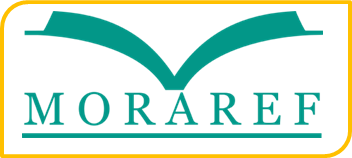DO PEER BANKS AFFECT ISLAMIC BANK FINANCIAL LEVERAGE DECISIONS?
Abstract
This research aims to analyze the influence of peer banks on Islamic banks financial leverage decisions. The empirical model was tested using fixed-effect panel data regression with robust standard error and the data of Islamic banks in Indonesia for the years 2007-2020. The results of this study show that peer banks have a significant positive effect on Islamic bank financial leverage decisions, and it is robust during the global financial crisis. The positive impact of peer banks on Islamic bank financial leverage shows that the higher the financial leverage of the peer banks will make the Islamic bank raises its financial leverage. This research contributes to the literature and policymakers on the presence of peer banks effect, especially in Islamic bank financial leverage decisions. Islamic bank financial leverage decisions are not only affected by the circumstances of the Islamic bank itself but are also influenced by other Islamic banks' behavior.
Keywords
Full Text:
PDFReferences
Ahadifar, A., Takanlo, Z. K., & Haghighat, J. (2021). Investigation of Factors Affecting Banking Leverage in Selected Iranian Banks (Random-Coefficients Approach). Journal of Money And Economy, 16(1), 21–42.
Al-Hunnayan, S. H. (2020). The capital structure decisions of Islamic banks in the GCC. Journal of Islamic Accounting and Business Research, 11(3), 745–764. https://doi.org/10.1108/JIABR-02-2017-0026
Al-Mutairi, A., & Naser, K. (2015). Determinants of Capital Structure of Banking Sector in GCC: An Empirical Investigation. Asian Economic and Financial Review, 5(7), 959–972.
https://doi.org/10.18488/journal.aefr/2015.5.7/102.7.959.972
Allen, D. E., & Powell, R. J. (2013). The Determinants of Capital Structure: Empirical evidence from Thai Banks. Information Management and Business Review, 5(8), 401–410.
https://doi.org/10.22610/imbr.v5i8.1068
Alzahrani, A. M., Rana, F., & Ahmad, S. (2021). Determinants of Capital Structure: A Comparative Study between Islamic and Conventional Banks in GCC. PalArch’s Journal of Archaeology of Egypt, 18(13), 1322–1332.
Amin, S. I. M., Ali, M. H., & Nor, S. M. (2018). Cost Efficiency and Liquidity Risk in Banking: New Evidence from OIC Countries. International Journal of Business and Management Science, 8(2), 255–276.
Bukair, A. A. A. (2019). Factors Influencing Islamic Banks’ Capital Structure in Developing Economies. Journal of Islamic Accounting and Business Research, 10(1), 2–20. https://doi.org/10.1108/JIABR-02-2014-0008
Erülgen, A., Rjoub, H., & Adalıer, A. (2020). Bank Characteristics Effect on Capital Structure: Evidence from PMG and CS-ARDL. Journal of Risk and Financial Management, 13(12), 310.
https://doi.org/10.3390/jrfm13120310
Fauziah, F., & Iskandar, R. (2015). Determinants of Capital Structure in Indonesian Banking Sector. International Journal of Business and Management Invention ISSN, 4, 36–44. Retrieved from www.ijbmi.org
Francis, B. B., Hasan, I., & Kostova, G. L. (2016). When do peers matter?: A cross-country perspective. Journal of International Money and Finance, 69, 364–389. https://doi.org/10.1016/j.jimonfin.2016.06.009
Guizani, M. (2021). The Determinants of Capital Structure of Islamic and Conventional Banks: an Autoregressive Distributed Lag Approach. Journal of Islamic Accounting and Business Research, 12(1), 131–147. https://doi.org/10.1108/JIABR-06-2020-0177
Guizani, M., & Ajmi, A. N. (2021). The Capital Structure Decision of Islamic and Conventional Banks: Empirical Evidence from Malaysia. Asia-Pacific Journal of Business Administration, 13(2), 216–234. https://doi.org/10.1108/APJBA-06-2020-0218
Hameed, N., Naveed, M., & Khan, S. A. (2019). How Financial Leverage Differs between Conventional and Islamic Banks: A Dynamic Model Perspective of Banking Sector in Pakistan. Journal of Islamic Business and Management, 9(2), 272–293.
https://doi.org/10.26501/jibm/2019.0902-003
He, W., & Wang, Q. (2019). The Peer Effect of Corporate Financial Decisions around Split Share Structure Reform in China. Review of Financial Economics, 1–20. https://doi.org/10.1002/rfe.1088
Leary, M. T., & Roberts, M. R. (2014). Do Peer Firms Affect Corporate Financial Policy? Journal of Finance, 69(1), 139–178.
https://doi.org/10.1111/jofi.12094
Lee, C., Lee, C., Zeng, J., & Hsu, Y. (2017). Peer Bank Behavior, Economic Policy Uncertainty, and Leverage Decision of Financial Institutions. Journal of Financial Stability, 30, 79–91. https://doi.org/10.1016/j.jfs.2017.04.004
Louhichi, A., & Boujelbene, Y. (2016). Credit Risk, Managerial Behaviour and Macroeconomic Equilibrium within Dual Banking Systems: Interest-Free vs. Interest-Based Banking Industries. Research in International Business and Finance, 38, 104–121.
Mohd Noor, N. F. (2018). Determinants of Islamic Bank’s Leverage Ratio in Malaysia. Management & Accounting Review, 17(1), 109–122.
Park, K., Yang, I., & Yang, T. (2017). The peer-firm effect on firm’s investment decisions. North American Journal of Economics and Finance, 40, 178–199. https://doi.org/10.1016/j.najef.2017.03.001
Pervin, R., & Nowreen, R. (2018). Determinants of Capital Structure of Commercial Banks in Bangladesh Listed in the Dhaka Stock Exchange Limited. ASA University Review, 12(1), 85–97.
Shah, M. A. R., Rashid, A., & Khaleequzzaman, M. (2017). Capital Structure Decisions in Islamic Banking: Empirical Evidence from Pakistan. Journal of Islamic Banking & Finance, 34(2), 88–103.
Shah, M. A. R., Rashid, A., & Khaleequzzaman, M. (2019). Determinants of Financial Leverage in Islamic Banks. Islamic Finance, Risk-Sharing and Macroeconomic Stability, 121–151. https://doi.org/10.1007/978-3-030-05225-6_12
Sheikh, N. A., & Qureshi, M. A. (2017). Determinants of Capital Structure of Islamic and Conventional Commercial Banks: Evidence from Pakistan. International Journal of Islamic and Middle Eastern Finance and Management, 10(1), 24–41. https://doi.org/10.1108/IMEFM-10-2015-0119
Toumi, K., Louhichi, W., & Viviani, J.-L. (2012). Alternative Financial Decision Principles: Theoretical Foundations of Islamic Banks’ Capital Structure. Recent Developments in Alternative Finance: Empirical Assessments and Economic Implications, 22(2012), 157–172.
https://doi.org/10.1108/s1571-0386(2012)0000022013
Zaighum, I., & Karim, D. M. Z. A. (2019). Peer effects, Financial Decisions and Industry Concentration. SEISENSE Journal of Management, 2(2), 13–21. https://doi.org/10.33215/sjom.v2i2.116
Zhong, T., & Zhang, T. (2018). “Peer effects” in Capital Structure Decision of Chinese Firms—Empirical Investigation based on Chinese A-Share Listed Firms. Nankai Business Review International, 9(3), 289–315.
DOI: https://doi.org/10.18860/ed.v10i2.17245
Refbacks
- There are currently no refbacks.
Editorial Office:
Megawati Soekarnoputri Building
Faculty of Economics
E-mail: eldinar@uin-malang.ac.id
Universitas Islam Negeri Maulana Malik Ibrahim Malang
E-ISSN 2622-0083

El Dinar under a CC BY SA 4.0 International License.
Member of:
Indexed By:
















